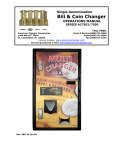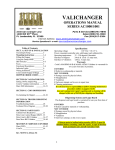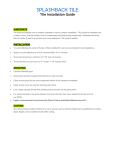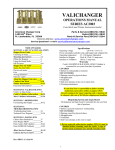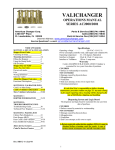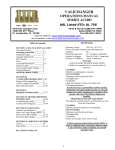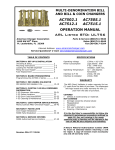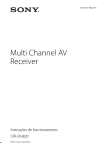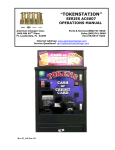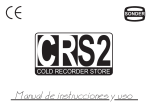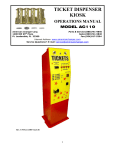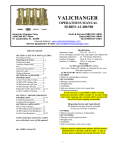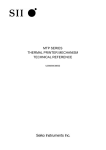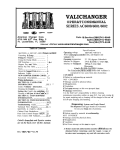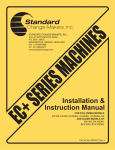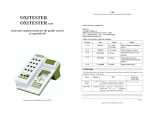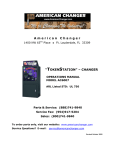Download Model AC6000 Manual
Transcript
VALICHANGER OPERATIONS MANUAL SERIES AC6000/6001/6003 American Changer Corp 1400 NW 65TH Place Ft. Lauderdale, FL 33309 Parts & Service:(888)741-9840 Sales:(800)741-9840 Fax:(954)917-5204 Internet Address: www.americanchanger.com Service Questions? [email protected] Rev. DBCG-1-A Jan’04 1 Attention Please: American Changer is now building in a Surge Suppressor on every main logic board made after September 1st, 1998. This will help eliminate power related noise problems for our customers. It will not protect you from large voltage spikes or lightning strikes over 150VAC. If this is a concern for your area of business, we recommend purchasing a surge protector locally NOTE: A POWER STRIP IS NOT A SURGE PROTECTOR. Thank You, American Changer Corp (888) 741-9840 MAIN LOGIC BOARD (ON SIDE WALL OF CABINET) QUICK CODE FAULT DEFINITIONS BILL METER / ERROR CODES DIP SWITCHES 00101 DUMP BUTTON RIGHT HOPPER ERROR CODE. LEFT DIGIT ALWAYS “0”. IGNORE! LEFT HOPPER ERROR CODE. Press the “DUMP” Button before turning off changer. Match the code to samples below to find out why the hopper(s) were shut down. LEFT HOPPER ERRORS 00000 00100 00200 00300 00400 01000 RIGHT HOPPER ERRORS 0 0 0 0 0 - NO ERRORS 0 0 0 0 1 - LOW COIN 0 0 0 0 2 - EXIT WINDOW JAM 0 0 0 0 3 - BAD HOPPER BOARD 00004 - JAMMED 00010 - NO ERRORS - LOW COIN - EXIT WINDOW JAM - BAD HOPPER BOARD - JAMMED - JACKPOT PREVENTED - JACKPOT PREVENTED IF THE “EMPTY” LED IS LIT, LOOK FOR CODES FOR BOTH HOPPERS TO BE DISPLAYED! 2 Table of Contents Specifications Operating voltage 120 VAC +10/-15 % Power consumpt.(controller only, add hopper and validator)10w Operating temperature 32 - 130 degrees Fahrenheit Interface to Hoppers 24vdc & 12vdc 1.5 amps max. Interface to Validators 120vac .5 amps max. SECTION A: SET-UP & INSTALLATION Uncrating & Setup 4 Mounting instructions 4 Filling the Hoppers 4 Using the Dump Mode 4 DIP Switches 4-7, 17 Bonus Pay Out Table 5 Hopper Pay out Table 6 Payout sub modes 6-7 Fuse 8 About the hopper/Coin sizes 8 Indicator Lights 8 Hopper Error Codes 2, 8 Audit Board Functions 9 Set-up/Using the optional Printer 10-12 Functional Descriptions 12-13 Wiring definitions 13 Converting AC6000 to MARS 13 Condor coin Mech Programming 13-14 Warranty CoinCo MAGPRO 00 B & MARS AE2601 Validator is warranted for two years from date of purchase. COVERED ¥ Defect in workmanship or material. NOT COVERED ¥ Damage caused by physical abuse. ¥ Misapplication ¥ Vandalism ¥ End users attempt, on his own to repair item ¥ Cleaning maintenance SECTION B: VALIDATOR INFORMATION Mars Validator Setup’s 15 CoinCo Error Codes 15 Clearing a bill jam in the CoinCo 16 Setting the CoinCo dip switches 17 CoinCo Validator information 16-21 Cleaning the CoinCo 20 Clearing a bill jam in the MARS 23 Setting the MARS dip switches 24 Cleaning the MARS 25 MARS error code information 26-27 It is the End User’s responsibility to follow cleaning maintenance procedure outline on page(s) 20/25. Any unit coming in for repair requiring only a cleaning will be charged a flat rate of $65.00 plus shipping and handling. Dispensing System and Logic Board The dispenser and logic board is warranted for one year from date of purchase. COVERED ¥ Defects caused by material or workmanship. NOT COVERED ¥ Damage caused by physical abuse. ¥ Misapplication ¥ Vandalism ¥ End Users attempt, on his own to repair. SECTION C: COIN HOPPER INFORMATION UN-Jamming the Coin Hopper 29-31 SECTION D: TROUBLESHOOTING INFORMATION Troubleshooting Guide 35 Technical Flow Diagram 36-37 SECTION E: PARTS LISTS Cabinet Parts Breakdown Parts Coin Control Hopper MKIV Parts CoinCo Bill Validator Parts MARS Bill Validator 38 39 40-43 44-46 MARS Service Centers CoinCo Service Centers 47-49 50 A Return material authorization number (RMA #) must be obtained before returning a unit for repair. A copy of invoices must accompany any and all warrantee work Rev. DBCG-1-A Jan’04 3 UNCRATING AND SET-UP Remove your Series AC6000/1/3 changer from the shipping box. Open the door. (The T-handles are a screw-in type and therefor, must be turned at least 10 times counter-clockwise until it opens.) Inspect for any connectors or components that may have been dislodged during shipping. The lock and keys for your changer will be inside the manila envelope along with this manual. To install the lock, insert the cylinder into the round hole in the middle of the T-handle and push until it stops. Now turn the key and lock until you hear it “snap." Turn the key counterclockwise ¼ turn and remove the keys. NOTE: The only way to get a duplicate set of keys made is to save the red tag that comes between the keys. This ID # starts with “ACC ####”. FILLING THE HOPPERS When each hoppers has less than 80 - 100 coins left the red “Empty” LED will light on the front of the changer. If you have disconnected your LED make sure the orange wire is going to the terminal on the LED that has the red positive mark next to it. Whenever the “Empty” LED is “ON” the validator is disabled and it will no longer accept bills. 1. Turn OFF the power on the main logic board. 2. Pour the coins into the large opening in the funnel on the top. There must be at least enough coins to cover the two gold plates at the bottom of the hoppers. (Somewhere between 160 and 17,000 coins minimum to maximum.) 3. Turn “ON” the power switch. The “Empty” LED is now off and the bill validator is ready to accept bills. Write your Key # here “ACC_____________”. ALL KEY ORDERS TAKE 4-6 WEEKS!!! MOUNTING THE AC6000 Remove the bottom door of the AC6000/1/3 and locate the 4mounting holes predrilled into the floor of the base. Using lag bolts, bolt down the machine to prevent the machine from being moved, shaken or tipped over. REFUSAL TO MOUNT THE CHANGER OR NOT USING ALL 4-MOUNTING HOLES MAY BE DANGEROUS!!! TEST: Before permanently installing the changer, do a functional test to verify that there is no shipping damage to your new changer(s). Extend the power cord through the hole in the back of the changer or the bottom and plug it into a grounded 120vac outlet. The dip switches are already set for a 4 coin per dollar payout of the hoppers, and the Bill validator is ready to accept $1-$5-$10-$20 dollar bills. Fill the each hopper with at least 100 coins. On the main logic board turn the switch on the bottom right corner “ON". (SEE FIG. 1 ON PG.3) The rocker switch has a “1” and “0” printed on it. When the “1” is pressed down the changer is “ON”. MAIN LOGIC BOARD Figure DIP SWITCHES 4. 5. THE DIP SWITCHES The AC6000-6001 series changer is capable of dispensing coins in different pay out modes. Setting the coins out per dollar is controlled by which Dipswitches turned “ON." (Refer to figure 1 for their location.) For example, switch #2 is “ON” on both dipswitches; therefor the payout equals 4 coins per dollar. Two coins per hopper for one dollar. 00001 EPRO M CHIP T R A N S F O R M E R BILL METER 1. 2. 3. USING THE DUMP MODE TO EMPTY THE HOPPERS Open the cabinet door. Turn OFF the POWER switch. Place a suitable container in front of the hoppers to catch the coins. Press and hold the “DUMP” button on the upper right corner of the Main Logic Board. Turn ON the Power switch. The red LED numbers on the main logic board will come on all “88888’s” then go all “00000’s”. Once the red “00000’s” light up, release the “DUMP” button. If it is not released within two seconds, the “DUMP” mode is canceled as a security feature. The hoppers will dispense coins until the POWER switch is turned OFF. If the red LED numbers are not counting up rapidly on the Main Logic Board’s display the dump mode was not accessed. Please try again. DUMP SWT. 1 ON 1 PRIMARY 2 1/2 AMP FUSE 2 3 4 5 6 7 8 VALIDATOR CONNECTORS HOPPERS HARNESS CONNECTORS FIGURE 2 (THIS IS NOT THE DIPSWITCH BANK FOR SETTING THE BILL DENOMINATIONS. (For those dip switches go to pages 18-19.) 1 0 ON/OFF SWITCH AC LINE CORD INPUT 4 5 6 HOW TO USE THE BONUS TABLE Think of the bonus table as the total amount of EXTRA tokens after the regular payout, that you wish to receive: EXAMPLE: PAYOUT: 4 tokens for $1, 24 for a $5, 52 for a $10, 120 for a $20. 24 tokens = $1 extra in tokens 52 tokens = $3 extra in tokens 120 tkns = $10 extra in tokens. Now go to the bonus table, find where the $5 column =$1 Look over to the $10 and go down until you see $3. Finally go to the $20 column to where = $10. You should be at 1-3-7; Turn “ON” your right dipswitches 1-3-7 to set this payout. DIPSWITCHES The following table shows how to set the dip switches to your desired payout. “ON” COINS PER DOLLAR #1 1 #2 2 #3 4 #4 8 The left dipswitch controls the left hopper’s pay out and the right dipswitch controls the right hopper’s pay out. Refer to the next table to set up your changer for the settings you need. MODE DESCRIPTIONS Some of the modes are self-explanatory while others have sub modes built into the chip. Here is a list of the modes and sub modes when applicable. MODE 2 - $1 coins the balance in quarters: The quarters for each bill are controlled by the sub mode settings of the right dipswitches #1 & #2. Neither “ON” – 16 Quarters balance in $1 coins. #1 “ON” only – 8 Quarters balance in $1 coins. #2 “ON” only – 12 Quarters balance in $1 coins. #1 & #2 “ON” – 4 Quarters balance in $1 coins. MODES’ #5 & #11 – Setting right dips in “$1 increments”: Refer to Page 6 Under “Dipswitches Con’t”. But instead of counting up in coins, think of it as dollars. Another way to look at the Bonus pay out mode is as follows: The bonus is paid out by the amount of tokens given for a dollar. For the below explanation we will say you are giving 4 tokens per dollar. Left dips #3-#6-#7 is ON. Right DipSwitch For a $5.00 bonus payout: #1 #2 20 tokens + no bonus OFF OFF 20 tokens + 4 extra tokens ON OFF 20 tokens + 8 extra tokens OFF ON 20 tokens + 12 extra tokens ON ON For the $10.00 bonus pay first double the pay out for the $5 bill. So if the total tokens given for the $5 bill was 24, the pay out for the $10 bill is 48 tokens. Now let’s figure out the bonus for the $10 bill. Right DipSwitch For a $10.00 bonus payout: #3 #4 $5 pay out + no bonus OFF OFF $5 pay out + 4 extra tokens ON OFF $5 pay out + 8 extra tokens OFF ON $5 pay out + 12 extra tokens ON ON Right DipSwitch For a $20.00 bonus payout: #5 #6 #7 $10 pay out + no bonus OFF OFF OFF $10 pay out + 4 extra tokens ON OFF OFF $10 pay out + 8 extra tokens OFF ON OFF $10 pay out + 12 extra tokens ON ON OFF $10 pay out + 16 extra tokens ON OFF ON $10 pay out + 20 extra tokens OFF ON ON $10 pay out + 24 extra tokens ON ON ON The following table shows how to set the dip switches to your desired payout. “ON” COINS PER DOLLAR #1 1 #2 2 #3 4 #4 8 If you want to dispense 5 dimes and 2 quarters per dollar turn “ON” switches #2 on the left and #1and #3 on the right dip switch. (2 quarters + 5 dimes = $1.00) The left DipSwitch controls the left hopper’s pay out and the right DipSwitch controls the right hopper’s pay out. Refer to the next table to set up your changer for the settings you need. MODE #14 – Canadian $1 &$2 coin payout: The right dipswitches #1 & #2 can alter the amount of $1 coins given to each denomination. Luni’s per $ $5 $10 $20 Neither “ON” - 1L 0L 0L #1 “ON” 3L 2L 2L #2 “ON” 3L 4L 4L The machine will always give 2 Luni’s for a Tuni. 7 FUSE Coin/Token Sizes Low voltage fuse: This is the secondary transformer fuse for the 5 - 28 VDC sections of the main logic board and hoppers. It is located to the left of the transformer. (See fig. 1) Replace this fuse with a 2-½ amp AS fuse only. REPLACING THIS FUSE WITH ANYTHING OTHER THAN A 2 ½ AMP “AS” MAY RESULT IN A FIRE OR AN UNSAFE WORKING CONDITION!! Indicator Lights Main Logic Board: 1. Green LED on: AC power applied to the logic board. All fuses are good. 2. Decimal Point: A. Heartbeat - 5 and 12vdc present. The changer is in standby waiting for a bill pulse. B. On Steady - Out of service, Hopper error detected. Validator logic board: 1. Red LED A. On Steady - Standby Mode, waiting for bill insertion. B. Flashing - Error mode, go to page for error code information. C. Off - The changer “Empty” LED is lit. The hoppers will automatically adjust to dispense coins/tokens in size from 20-30 mm in diameter and 1.25 3.5 mm in thickness. There is an option available to dispense smaller coins. A nickel is approximately 21 mm, a quarter is approximately 25mm. A Susan B. Anthony is 28mm Hopper coin bin. (Dump the coins into this hole. 1600 coins max.) Coin counting LED. Security LED. (all systems OK) 12vdc Power LED. Coin counting optic. Coin Control Hopper MKIV Three green LED indicators are fitted on the hoppers and are visible in the section where the coins exit the hoppers. From left to right these are designated as follows: 1. 2. 3. Logic power supply on (12 & 24vdc present). Security optical obstruction indicator -. Should be ”on” when unit is OK. Output indicator, indicates coin passing photo-sensor. This is the optical sensor the coin will obstruct on its way out of the hoppers. For normal operation LED # 3 will be off until coins are dispensed. LOGIC BOARD ERROR CODES We now have the ability to display error codes in dealing with the problems associated with the changer. There are 2 different locations error codes can be displayed depending on the source of the problem. If the “Empty” LED on the outside of the changer is lit: 1. Press and hold in the “Dump” button on the main logic board. 2. The display now shows the code for your problem. Bill Meter Display 0 0 0 0 0 Left Hopper Codes 12 pin male connector. (located on the opposite side.) Motor The right & left hopper has a removable coin chute installed. Replacement hoppers are not sent with this coin chute. Left chute P# AC2010-104 & Right chute P# AC2010-114 Error Codes: 01 = Low Coin 02 = Coin exit window is blocked 04 = Under-payment was detected 10 = Over-payment was detected and Prevented. (Jackpot condition) A “03” error code is a low coin and exit blocked in the same hopper. Right Hopper Codes 8 AC6065 AUDIT BOARD FUNCTIONS The audit board is mounted to the back of the AC6000/1 door and was made to give a visual breakdown of audit counts for individual counts on: quarters, ones, fives, tens and twenties. By pressing the button associated with the counter on the audit board the display will change from an exact dollar/change reading accepted by the changer to the individual counter accepted by each denomination. I.e. if you were to press the “quarter” button and “132” were to be displayed, that would mean the machine had accepted 132 quarters or $33.00 in quarters. Left Validator Connector Right Validator Connector Eprom Press these 2 buttons simultaneously to reset counters to “$0000.000” To reset the counters to zero press and release the two outside buttons (quarters + $20) simultaneously. After the NEXT bill is inserted the counter is reset to zero! 9 THE (AC7070) PRINTER OPTION UPGRADE Installation & programming instructions SECTION A. – General Information All AC7070 Printer Boards (PB) are year 2000 compliant. Figure 1 American Machine ## Sequence # Printer With Paper Option Buttons #1-#4 Top Connector #3 A 8 9 Bottom Connector #2 Battery 2-Year Shelf life Ribbon Connector #1 FAST FACTS: 1. Replace battery every 2-years with a 3VLithium #CR2320, Positive side UP. It is a very common battery and can be found just about everywhere, even Radio Shack. Replace battery with the power on so not to lose the existing programming. 2. Replace paper with: A. Nippon TP50KS-E2C or TP50KS-A B. Honshu FH65BU-2 or FH65BX-14N C. Mitsubishi F-200U9W3 or F-200U7N5 Using any other paper than the type specified will dramatically cut down the life of the printer. Office Depot should carry at least one of these paper types.. 3. Change the paper with power on at the printer board. Feed the paper into the back of the printer until it stops. Press and hold the #3 paper feed button until the paper comes into view. 4. The dial in the lower right corner of the print board is to set print contrast. DO NOT MAKE THE CONTRAST to dark. It will cause the print head to burn up. It should be set to be just legible. 5. Logic EPROM Ver.B-06 Print Contrast Adj. Dial THE PRINTER IS MAINTENANCE FREE!!! Do not try to mechanically adjust, lubricate or pry on the printer. ANY PRINTER MAINTENANCE VOIDS THE WARRANTY!!! Blowing the dust out of the printer with canned air every 6-monthes is recommended and required by the warranty. SECTION B. – Installation INSTALLATION OF THE AC7070 PRINTER BOARD ON INDIVIDUAL MACHINES. If the Printer was installed at the factory skip to Section C 1. 2. 3. 4. 5. 6. 10 Remove power from the machine. Remove the hoppers from the machine. Remove the hopper plates and disconnect the harnesses from the Main Logic Board. Remove the original validator harness. Install the new plates and connect the harnesses to the Main Logic Board. (Right plate to the bottom hopper connector.) Make sure the inside left wall of the AC2000 series cabinet is free of dirt and oil. machine is number “000”. Follow the directions on the printout. Every time you press the # button the red light will flash and the digit associated with that digit counts up by one. DO NOT RUSH!!! IF YOU DID NOT SEE THE RED LIGHT ON THE PRINTER BOARD FLASH YOU COUNT DID NOT INCREMENT!!! If you made a mistake, press OK (#4), then #2 to restart the operation. For a sample we’ll assign #358 as our machine number. 1. Press the #1 button 3 times to set the “hundred’s” digit.. (Try to press once per second. This is a good rhythm. Ensure the red light on the printer board also flashed three times.) 2. Press the #2 button five times to set the “ten’s” digit. 3. Press the #3 button 8 times to set the “one’s” digit. 4. Press #4 OK. (If the printer does not show the desired machine number press#2, and go back to step #1) 5. Press #4. The printer will now print a receipt showing the new machine number at the top of the paper. 7. Peel the covers off the 4 stick pads at each corner of the board. 8. Attach the board firmly onto the side of the cabinet by pressing firmly in each of the Four Corners of the board simultaneously. 9. Connect the RIBBON CABLE to the AC2000 series on the Printer Board. 10. Attach the RIBBON CABLE to the pigtails of the hopper plates. 11. Attach the new validator harness. Connect it to the lower plug on the Main Logic board, the Empty LED, and to the Bottom Connector #2 on the Printer Board. 12. Reinstall the hoppers onto the hopper plates. Section C. – Printout Description. DESCRIPTION OF THE PRINTER’S PRINT-OUT When you first receive your Printer, you will see a printout on the tape sticking out of the Printer. Below is the description line by line: Machine # - This will be programmed by the user later. It is the programmable number designation assigned for this machine. Sequence # - This is the audit number assigned to the receipt. The printer will print out 2 receipts per sequence. Date & Time – Date and time the printout occurred. Quarters through Hundreds – The amount of each currency accepted since the printer was last reset. Sum – The amount in dollars the printer has accumulated since it was last reset. Total – The amount in dollars the printer has accumulated in it’s lifetime. THIS TOTAL CAN NEVER BE RESET!!! Hopper 1 & Hopper 2 – The amount of coins given out of each hopper since the printer was last reset. In a 1-hopper machine only, Hopper 1 will accumulate. Time – Reenter the program mode and this time press #2 for the 24-hour clock. In the sample below I will use 9:52 AM. (For those of you unfamiliar with this type of time setting here is a sample. 1:00 AM = 0100 hours, Noon = 1200 hours, 1:00 PM = 1300 hours, 6:00 PM = 1800 hours, Midnight = 0000 hours.) 1. Press #3 for the TENS setting on the 24hour clock. (Since the sample time is 9:52 AM or 0952 hours DO NOT PRESS#3. Just hit #4 to move on.) 2. Press #3 9 times to set the hour, then press #4. 3. Press #3 5 times to set the hour, then press #4. 4. Press #3 2 times to set the hour, then press #4. 5. Press #4 OK. (If the printer does not show the desired machine number press#2, and go back to step #1) . 6. Press #4. The printer will now print a receipt showing the new time at the top of the paper. THE DENOMINATIONS AT THE BOTTOM OF THE PRINTOUT REPRESENT THE LAST 3 BILLS ACCEPTED BY THE BILL ACCEPTOR(S). Section D. – Programming the Printer. How to Program the AC7070 Printer Option There are 4 programming modes associated with the Printer: Machine #, Time, Date, and the ability to make the “SUM” on the printer printout resetable or non-resetable. To enter the programming mode, turn the main logic board of the machine off. Press and hold down the #2 & #3 while turning on power to the main logic board. Release the #2 & #3 pushbuttons as soon as the printer head move, (Approx. 1 second).. The Printer prints out “****Set up Mode****” and you’re ready to start! Now that we’re in the set up mode let’s press #1 to set machine number. This number represents this machine. This way if you have multiple printers and receipts scattered on your desk, the machine number will tell you which machine the receipt is for. This number has three digits. Right now the Date – Reenter the program mode. The sample will be May 15th 2000. 1. Press #3 for the date mode. 2. Press #2 for 2000 then press enter. 3. The printout shows 2000, if it is correct press #4. 4. Press #4 for the “ten’s” digit of the year. 5. Press #3 to set the “one’s” digit of the year. For the example press #3 2 times. 6. The printer now shows the completed year., if it is correct press #4. 7. To set the month “ten’s” digit press #3. In the example the month is ‘05’ so press #4 . 11 8. Set the “one’s” digit of the month, in the example press #3 5 times. Press#4. 9. Press #4 if printout matches the month. 10. Set the “ten’s” digit of the date by pressing #3. 11. Press #3 to set the “one’s” digit of the date. 12. Press #4 if date printout is correct. The printer will now print a receipt showing the new date at the top of the paper. Resetable Counter – This feature either locks the “Sum” total on the printout, or allows it to be reset each time you increment the sequence number. 1. Enter the program mode. 2. Press #4. 3. Locked – YES or NO. The printer will now print a receipt. 4. 5. 6. Section E. – Printer Operation The Printer operation is fairly simplistic. The Printer gets its input pulses from the bill validator and sorts them into the categories such as “quarters” and “twenties”. For the “hopper” category, each hopper ‘s exit window is monitored and each coin is counted as it’s dispensed. 7. 8. Using the Printer – Once installed the printer should be used as any normal accounting device. THE PRINTER WILL NOT LOSE ANY ACCOUNTING INFORMATION WHEN POWER IS LOST! A printout can be obtained by pressing the “PRINT” (#2) button. This action will not reset the accounting features. It is a monitoring printout only! Another helpful feature of the Printer is the printout of the last 3 bills entered. This feature was installed to double check customers that say they lost money in the machine. NOTE: THE METER ON THE MAIN LOGIC BOARD CANNOT BE RESET TO ZERO!!! Functional Descriptions of Out-of-Service Conditions Out-of-Service conditions occur for the Series AC6000-6002 changer for the following reasons: low coins, hopper fault error, validator fault, or a blown fuse. Every accounting period the Printer will need to dump it’s information and start over. This is accomplished by pressing the #1 and #4 buttons simultaneously. The printout will have *Reset Count Receipt* at the top. There are 2 receipts printed, then the counters are reset to 0. 1. THE “TOTAL” COUNT CAN NEVER BE RESET!!! (End Printer Description Section) Functional Description of the Series AC6000-6003 Changer To follow along with this walk-through of your changer, fill the hoppers with coins and turn the changer on. 1. 2. 3. bill looks like to its memory. After the bill is validated it grounds the 5vdc lines causing a pulse along the yellow and blue validator harness wires to pins 5 and 15 of the main logic board. Each pulse stands for the amount of the denomination validated. (i.e. 1 pulse for $1, 5 pulses for $5). The 5vdc pulse then travels from pins 5 and 15 to the EPROM chip (DBCG-1) pin #25. The EPROM sends a 12vdc pulse to the meter chip (U5) out pins #21 & 22 (one pulse per denomination validated ).The EPROM also multiplies the bill pulse by the DipSwitch settings (The EPROM reads the DipSwitch settings during the power up mode and stores them into memory.) The EPROM then sends the hopper pulses out pin #23 to pins 6 and 7 of the red 12 pin hopper plugs. These pulses travel through the purple and brown wires of the hoppers wire harness to the hoppers pins 8 and 12. The hopper turns itself on with the first hopper pulse. The hoppers counts the hoppers pulses sent from the EPROM chip on IN3 (pin 12) while dispensing the coins at the same time. When the amount of hoppers pulses in equals the coins dispensed through the coin counting optical sensor the hopper turns itself off. The Changer returns to the standby mode with the decimal point flashing once per second until another bill is inserted. 2. When power is applied the validator will cycle twice, the out-of-service LED flashes then goes out, the green LED on the main logic board comes on steady, and the decimal point on the main logic board number display will flicker on once per second in the standby mode. During the power-up mode the main logic board relay clicks twice enabling power (120vac) to the validator. When this relay is not enabled it routes 12vdc ground to the out-ofservice LED. Without power to the validator the changer cannot accept bills. Since we are not in the error mode, the red LED on the validator logic board is on steady. When a bill is inserted into the validator bill slot, the bill will be pulled inside. The validator then compares what the 12 Blown Fuse: an AC power spike in line voltage or a bad transformer on the main logic board can cause A blown fuse on the main logic board. If either fuse blows the indication is the green LED on the main logic board will not light. A. Replace the fuse. If the green LED now lights then there was a spike. B. If it does not and the fuse blows again the power transformer is shorted. To test the transformer use a voltmeter set for ohms and measure across the primary (40ohms) and the secondary (1.5ohms). Hopper Fault: A hopper fault can either be a jammed hopper, a blocked coin counting optic or a bad hopper logic board. A. Indications for a jammed hopper are the changer accepts bills, the meter counts up, but nothing or not enough coins are paid out. 1. After 2 minutes the EPROM shuts off the validator if the coins are not paid out correctly. The “Empty” LED will flash once per second. 2. At this point the three options open are to attempt repair on your own, call your distributor, or return the defective hopper to American Changer. B. Indications for a blocked coin optic or bad hopper logic board are the out-of-service LED on the 3. 4. outside of the changer is lit and the red LED on the main logic board is lit and flickers off once per second. 1. If two of the 3 green LED’s on hopper logic board are lit then the hopper logic board is bad. 2. If there is a coin or foreign object caught in the coin exit window LED’s #1 and #3 will be lit on the hopper logic board instead of LED’s #1 and #2. a. Take off the side of the hopper with the 5 Philips screws. Pull up on the exit window logic board and look for the jammed item. b. Ensure you have the pins aligned before reconnecting logic board. Validator Fault: When a validator fault occurs the validator’s EPROM shuts down the validator and flashes an error code via the red LED on the validator logic board. When there is no error this LED is on steady. The validator only gives bill pulses to the main logic board so the main board never knows if the validator isn’t functioning. Therefore the out-of-service-LED will not light. (See page 7 for validator error codes.) Low Coins: The low coin condition is probably the most common fault. The EPROM on the main logic board is constantly checking for low coins in the hoppers. This is done with a low current 5vdc signal on pin #3 of the hopper’s output connector. The voltage then travels down the hopper’s wire harness on the white wire to pin #7 of hopper’s plug. The signal is applied to one of the gold low contact plates at the bottom of the hoppers. The 5v travels through the coins through the other contact gold plate to hopper’s pin #2. It then goes through the black wire in the hopper’s harness to pin #10 on the main logic board. Any interruption of more than 1/2 a second will cause an out-ofservice condition. A. Clean the bottom gold plates of the hoppers with steel wool or fine sandpaper. Refill the hoppers and try again. B. Check continuity, (0 ohms) resistance, from pins 3 (white) and 10 (black) of the red hopper harnesses. Make sure both hoppers are full and the changer is turned off. 1. If the continuity is 0 ohms, replace the main logic board. C. Pull the hoppers out of the changer, then look at the 12 pin black male connector that sticks out of the hoppers. Place the continuity checker’s leads on pins 2 & 7. 1. If the continuity is 0 ohms, replace that hopper’s plate or adjust the hopper’s plate female socket’s pins so that they are not so spread out. 2. If the continuity is infinity, then replace that hopper. WIRE HARNESS COLOR AND DEFINITIONS Validator harness: Switched Hot 120VAC. Neutral 120VAC. 120VAC Low current validator enable. +5vdc credit pulse line. -5vdc credit pulse line. +12vdc Empty LED. -12vdc Empty LED. Hopper Harness Gray - Coin counting optic status line. White - Low coin sense (+5vdc). Green - Coin counting optic pay out feedback line. Yellow - Raw sensor output line. Purple - Hopper pay out line from main logic board (+), Brown - Hopper pay out line from main logic board (-). Red +12vdc logic board supply voltage. Black(s) -12v, 24v low coin sense ground. Orange - +24vdc Motor supply voltage. Red White Black Yellow Blue Orange Brown - Converting CoinCo to MARS AE2601’s Machines made after September 2002 (Serial # 02366-------) To convert these machines first ensure the correct harnesses have been ordered. (Part # AC1061.1-4H = Validator Left Harness, AC2062.1-2H + AC2066.3-1H = Right Validator Harness + Condor Coin Mech Adapter (if required)). 1. Remove Power & the Factory Harnesses. 2. Remove the CoinCo’s. 3. Loosen the 4 nuts on the door & slide the right side door validator bracket to the lowest position then retighten. 4. Install Right MARS Validator. 5. On the left side folding validator bracket, flip the bracket forward & remove the 2 adjustment screws from behind. Place the bracket on its lower setting and re-install the screws and tighten. 6. Install the left MARS. 7. Install both wire harnesses. Ensure you plug the Door Mars validator to the left side Audit or TOP printer connection and the Flip bracket Mars to the right side Audit or BOTTOM printer connection. 8. Set page 24 to set the DipSwitches. Condor Electronic Coin Mech. Programming The next page will teach you how to program the Condor. (End Functional Descriptions Section) If you have an AC6000 Program the $1 coin in the #1 Slot. You can not accept Quarters and dollar coins with out a new wire harness. If you have a AC6001 or AC6003, program the Quarter into the #1 slot and the dollar coin in the #4 slot. 13 14 Interfacing the Mars AL-4 or AL-4 Plus Series with the ValiChanger 8-Position Switch 4-Position Switch 1 on 1 off 2 off 2 off 3 on 3 off 4 on 4 off 5 on 6 off 7 off 8 on The 18-pin connector is not required. VALIDATOR INTERFACES 18 PIN INTERFACE CONNECTOR DETAILS Pin #1 PLUG KEY Pin #10 Pin #9 Pin #18 Ensure the black & yellow wires go to a wire nut and the green & white go to the other wire nut Interfacing the Mars 2501/2511 Series with the ValiChanger 8-Position Switch 1 off 2 on 3 off 4 on 5 off 6 on 7 off 8 off No change is required to the 18-pin connector.. Ensure the black & yellow wires go to a wire nut and the green & white go to the other wire nut CoinCo MAGPRO Series Flash Codes Flash codes 1-18 may appear during normal servicing of the BA30. If more than one error or condition exists, the lower number flash code will appear until its respective error or condition is corrected. The left and right sensors referenced below are given viewing the BA30 from the front. # of Flashes Description of Flash Codes 1 Bill box full 2 N/A 3 Check bill path 4 All bill accept switches are off 5 Bill jam or sensor error 6 Stacker motor/home sensor 7 Transport motor/encoder sensor 8 N/A 9 EPROM Has Failed 10 EPROM Has Failed 11 Center Optic Failed 12 Right Optic Failed 13 Left Optic Failed 14 Bill Position Sensor Error 15 Right Bill Position Sensor Error 16 Left Bill Position Sensor Error 17 Lower Anti-Stringing Armature out of place 18 Upper Anti-Stringing Armature out of place Interfacing the Mars 2601/2611 Series with the ValiChanger 8-Position Switch 1 on 2 on 3 on 4 on 5 off 6 on 7 off 8 off The 18-pin connector is not required. 15 COINCO MAG50B VALIDATOR SECTION PAGE 16 Removing the Bill Box 17 Clearing a bill jam 17 Setting the bill types accepted 18-19 Cleaning the sensors 19-20 Cleaning a salted unit 20 Replacing the belts 21 Removing the bill box. To remove the 1000 bill stacker from the CoinCo validator follow the picture below. REMOVING A BILL JAM From time to time a foreign object or ripped bill will become caught in the validator. Follow the picture below to remove the item. 17 SETTING THE BILL ACCEPT DIP SWITCHES 18 CLEANING THE BILL VALIDATOR Refer to the pictures and the procedure on the next page to clean the bill validator every 4-6 months. 19 MAGPRO CLEANING: IF ANY OF THESE PROCEDURES ARE PERFORMED TO YOUR VALIDATOR AFTER IT IS RETURNED UNDER A WARRANTY REPLACEMENT, YOU WILL BE SUBJECTED TO A $65.00 LABOR FEE. CLEANING AND MAINTENANCE: Note: Petroleum-based cleaners and freon-based propellants can damage plastic and some electronic components. Scouring pads and stiff brushes may harm the protective conformal coating on the circuit boards and can mar the plastic. These items should never be used when cleaning the MAGPRO bill acceptor. 5. Remove the bottom cover from the lower The MAGPRO should be cleaned every 7,000 bills housing. or every 4 -6 months (or as needed, depending 6. Run hot water (1101/4-1401/4F) over the lower on the environmental conditions of the housing from the top and bottom. Using a soft location). Dust can be removed with a soft brush, gently clean any residual salt. Use a soft brush or cloth or it can be blown out using absorbent cloth to clean any residue off the lower compressed air. housing. If the transformer gets wet, allow the Procedure: unit to dry for 24 hours before applying power. 1. Disconnect power from the bill acceptor. 7. Remove the front mask. Using hot water and a 2. Remove the bill box and use a soft cloth to wipe soft brush, clean the front mask, upper sensor the dust from around the intermediate frame and board, main frame anti-pullback levers and stacker plate. position sensor mount. 3. Remove the lower track. Caution: The motors are not protected from water, 4. Using compressed air or a soft brush, blow or therefore the unit must be held in a manner that brush the dust off of the optic sensors and out of the prevents water from running over the intermediate recessed sensor openings. frame crossbar. 5. Remove dust from around the belts and wheels on 8. Remove the position sensor cover on the crossbar the lower housing and the sensors on the upper and carefully lift the LED from its mount. (Early sensor board. The upper sensors are located directly models only.) above the lower housing sensor when the lower Caution: Protective coating on the LED leads should housing is installed. not be damaged. Clean all salt residue from the 6. The bill path can be cleaned to remove further dirt mount, sensor hole and detector area. and oil using a soft cloth moistened with a mild soap The detector can be seen through the sensor hole, and water solution. and is located in the chassis. Replace the position 7. Clean the magnetic head using a swab and sensor cover. (Early models only.) isopropyl alcohol. 9. Verify that the anti-pullback levers move freely 8. Once the lower housing is dry, place it back into and that the spring returns them to their open the mainframe so that the tab on the bottom locks position. into place. 10. Allow the unit to dry thoroughly. 9. Blow the dust out of the encoder wheel and its 11. Clean the magnetic head using a swab and sensors. (It may be necessary to extend the stacker isopropyl alcohol. plate to access the encoder wheel. Supplying power 12. Replace the front mask to the unit momentarily can do this, so that the 13. Replace the lower housing cover. stacker plate extends.) 14. Replace the lower housing into the main frame. 10. Remove dust from the transport belt areas and 15. Remount the bill box. from any other places of build up. 16. Apply power and insert bills to verify that the unit 11. Remount the bill box. is functioning properly. 12. Apply power and insert bills to verify that the unit 6 OR 7 ERROR CODE FLASHES is functions property. The cleaning procedure for this common occurrence is listed below. Just follow these steps. MAGPRO CLEANING PROCEDURE FOR SALT 1. If this code has occurred on a new machine or WATER POLLUTED UNITS: one that the validators DIP switches were just Note: Petroleum-based cleaners and freon-based changed, Ensure that all the white plugs on the propellants can damage plastic and some electronic side of the validator board away from the red LED components. Scouring pads and stiff brushes may are plugged in securely. harm the protective conformal coating on the circuit 2. Remove the bill box. boards and can mar the plastic. These items should 3. Turn the Changer ON then OFF in an attempt to never be used when cleaning the BA30 bill acceptor. stop the metal push plate so that it COASTS into Procedure: the fully outward position. 1. Remove power from the bill acceptor. 4. Using an air compressor or a can of compressed 2. Remove the bill acceptor from the vending air blow out the area behind the push plate until machine. it is completely free of all dust and lint. 3. Open the bill box lid and verify that the stacker 5. Turn the changer power back on so that the push plate is in the stand-by/home position. If it is not plate returns to the inward position. If the same in the home position, apply power and observe error code persists, repeat steps 1 - 3 that the stacker plate returns home. concentrating on the top center area behind the Warning: If moisture is present, allow the unit to dry plate. thoroughly before applying power to avoid possible 6. Replace the bill box. shock hazard. If the stacker plate does not return to the home position, remove power and carefully remove the bill box to avoid damaging the bill box and/or stacker plate. 4. Remove the lower housing. 20 REPLACING THE BELTS Every 2-3 years the belts on the CoinCo will wear out. To replace them, remove the validator components down to the picture show. Refer to the parts diagram at the end of the manual for help getting to this point. 21 MARS AE2601 MEI MARS AE2601 VALIDATOR SECTION PAGE Removing the Bill Box 23 Clearing a bill jam 23 Setting the bill types accepted 24 Cleaning the Validator 25 Coupon Programming (Dip Switch) 26-27 Trouble Shooting & Trouble Codes 28 In order to use the Mars type VN2611 type validator the door must be changed out to the “UNIVERSAL style” with the large cut out openings. This is not a problem when using the Mars VN2601 style validator! BILL ACCEPTOR 120VAC $1-$20 See Page 13 for instructions to convert from CoinCo to Mars AE2601. 22 Removing the bill box 2. Push BLUE button forward. 1. Push bill box up and out. Clearing A Bill Jam 1. Pull up on silver bar (Rod) 2. Pull bar away from the Mars. 23 Setting the Dip Switches 24 Cleaning & Maintenance Cleaning You can clean the bill acceptor while it is still mounted in the machine. 1. Remove power from the machine. 2. Unlatch the magazine by pushing the blue latch (located on the top of the unit) toward the front of the unit. 3. Unhook and remove the magazine by holding the latch and lifting up and then back on the magazine. 4. Unlatch the LED Housing by lifting up on the metal bar (located below the Status LED). 5. Remove the LED Housing by holding the metal bar and pulling back on the LED Housing. 6. Clean the bill path with a soft cloth. You may use mild, non-abrasive, non-petroleum based cleaners if sprayed on the cloth. 25 Coupon Configuration THIS IS NOT A USABLE COUPON! DO NOT COPY!!! FIGURE 1 The AE2601 may be configured using a coupon. The coupon is included in the AE2601 Series Installation Guide. Carefully cut the coupon along the dotted-line edge to remove it from the installation guide. Copies of the original coupon may be produced with a standard, carbon-based, non-color copier. Cut copies to match the size of the original coupon. All option switches must be in the OFF position for the coupon selections to be active. The coupon selection will remain with the AE2601 until the unit is reprogrammed, even if power is removed. When filling out the coupon, note the following: Use only a #2 pencil to fill in the blocks Fill in the entire block Do not mark the coupon outside the blocks or on the back of the coupon Fill in ONE block for EVERY line Coupon Programming 1. Fill out the coupon using the table below. 2. Locate the service button on the back of the unit (refer to Figure 2). 3. Press the button once to enter the coupon setup mode. Pressing again will exit the mode. The unit will automatically exit coupon setup mode upon acceptance of the coupon configuration. The LED Status indicator (located to the left of the service button) will flash rapidly indicating that the unit is in coupon setup mode. 4. Insert the coupon marked-side up. The AE2601 will pull the coupon in, read it, and then return it to the user. A good coupon will be returned immediately. After the coupon is pulled from the bill acceptor mouth, the unit will flash the Status LED ten times to confirm a good configuration. A bad coupon will be held for ten seconds before being returned. This delay is to make you aware that there is a problem with the coupon. When the coupon is pulled from the bill acceptor mouth, the unit will flash the Status LED the number of times corresponding to the section of the coupon wherein a problem lies. For example, if 26 FIGURE 2 the problem is in section five, the LED will flash five times. Section numbers are located to the far right of each section on the coupon. 5. If the configuration is rejected, check the coupon and repeat the process. Trouble Codes 3 Flashes - Indicates that the bill path needs cleaning for optimum performance. Remove the magazine and LED housing and follow cleaning instructions (page 29) to clean the bill path. Status LED A Status LED provides assistance in diagnosing the condition of the Series AE2600. The following is a description of the LED codes, their meanings, and suggested remedial actions. 4 Flashes - Indicates that something is obstructing the bill path. Remove the LED housing and look at the bill path on the housing and inside the unit for foreign material; clean as necessary. LED ON - Indicates that the unit is enabled and ready to accept a bill. No action is necessary. LED OFF - Indicates that no power has been applied to the unit. Check to ensure that power is applied. 5 Flashes - Indicates that the magazine is removed (the unit will not accept without the magazine attached). Reinstall the magazine. 1 Flash - Indicates that something is obstructing the bill path. Remove the magazine and LED housing. Inspect for foreign material. Continuous Slow - Unit is defective. Replace the unit. Continuous Fast - The magazine is full of money. Remove the money from the magazine. 2 Flashes - Indicates that the unit is not enabled. Verify configuration. Check the dipswitches. 27 MKIV UNIVERSAL HOPPER INDEX PAGE 1. Coin box removal & reassemble 29-31 2. Exit window replacement 30 3. Logic board replacement 31 4. End plate removal 31 5. Track plate removal 32 5a. Track plate assembly 32 5b. Track plate replacement 33 5c. Final drive gear replacement 33 6. Gearbox assembly 34 7. Motor replacement 34 To un-jam the hopper, refer to sections 4 – 5b, pages 31 –33. SERVICE MANUAL 28 1. COIN BOX REMOVAL 1. Place the hopper in front of you as shown, (looking at the outside of the ‘coin box’). Refer to FIG 1. 2. Remove the 2 locking nuts, which hold the ‘low level sense plate’ wires to the studs. 3. Remove the crimp & wire from the studs. ACCESS IS NOW AVAILABLE TO THE ‘LOW LEVEL’ SENSE PLATES, THE MAIN PCB, THE EXIT WINDOW, THE MOTOR TERMINALS & PART OF THE WIRING LOOM. 1a. COIN BOX ASSEMBLY 1. Refer to FIG 1a. 4. Remove the 5 screws indicated (B), which hold the ‘coin box’ to the ‘center plate’. Refer to FIG 1b. 6. Gently lift the ‘coin box’ away from the rest of the hopper. NOTE:- The ‘logic board’ & ‘stirrer’ are located in the ‘coin box’. 7. As the ‘coin box’ is being removed, carefully slide the ‘logic board’ out. The stirrer may stay with the ‘coin box’ or fall onto the center plate. 29 Firstly, locate the ‘stirrer in the ‘coin box as shown in FIG 12. COIN BOX ASSEMBLY (cont.) 2. Line up the ‘centre plate’ & ‘coin box’ as shown below. FIG 12a. 3. Route the ribbon cable as shown below. 4. Fit the ‘logic board’ into slots shown below. 5. Feed the level sense wires through the slot shown below. 7. Align the ‘center plate’ & ‘coin box’ & push together. 8. Turn the hopper over & refit the screws. 9. Refit the level sense wires. 2. EXIT WINDOW REPLACEMENT 1. First, remove the ‘coin box’, section 1. This will then enable access to the ‘exit window’ 2. Unscrew & remove the 2 fixing screws. FIG 4. 3. Remove the ‘exit window’ from the ‘center plate’. 4. Unclip & remove the 10-way ribbon cable header. 5. 6. Lift the ‘centre plate’ to meet the ‘coin box’. FIG 12b & c. 30 To re-assemble, follow the above steps in reverse. 3. LOGIC BOARD REPLACEMENT 1. First, remove the ‘coin box’, section 1. This will then enable access to the ‘logic board’. 5. To re-assemble, follow the above steps in reverse. 5. TRACK PLATE REMOVAL 1. 1. First, remove the ‘end plate’, section 6. See FIG 7. 10-way ribbon IDC socket (CONN 1). 2. 3. 4. 5. 6. 7. 8. 2. Move the two ejector arms at right angles to & away from the connector, if fitted. This should release the socket from the header. Clasping the connector between thumb & forefinger, pull away from pin header. 14-way crimp socket (CONN 2). Gently, unclip the “friction lock” from the connector housing. Clasping the connector between thumb & forefinger, pull away from pin header. The Logic Board is now released. To re-assemble, follow the above steps in reverse. 4. END PLATE REMOVAL 1. Place the hopper in front of you as shown, (looking at the outside of the ‘end plate’). Refer to FIG 6. 2. Remove the 9 screws indicated (B), which hold the ‘end plate’ to the ‘center plate’. 3. Locate the position of the ‘connector blanking piece’. 4. Holding the ‘connector blanking plate’ gently lift the ‘end plate’ away from the rest of the hopper. 31 The ‘elevator track’ & ‘final drive gear’ can now be removed by lifting up & away from the ‘center plate’. 5a. TRACK PLATE ASSEMBLY The following 3 sketches show how to take the ‘track plate’ apart. The following 3 sketches show how to assemble the ‘track plate’. 32 5b. TRACK PLATE REPLACEMENT 1. The gray shaded area, in FIG 7b, is the ‘track plate’ guide path. FIG 7b. 2. Once the ‘track plate’ is in position, turn the track through 720 0 to ensure it is seated in the guide path correctly. 5c. FINAL DRIVE GEAR REPLACEMENT 1. 2. Once the ‘elevator track’ is in place, the ‘final drive gear’ can be fitted by placing the gear over its mounting spindle, while lining the teeth up with the secondary drive gear, adjust the ‘elevator track’ so that the gear falls into place. FIG 7c. The end plate can now be re-fitted. See section 6. 33 4. 6. GEAR BOX ASSEMBLY 1. Remove the end plate. Section 6. 2. Remove the ‘elevator track’ & ‘final drive gear’. Section 7. 3. Remove the gearbox cover. Section 8. Access to the motor fixing screws is now possible. 5. 7. MOTOR REPLACEMENT 1. Remove the ‘coin box’. Section 1. 2. Unsolder the red & black wires from the motor. NOTE: The black wire connects to the terminal marked with a RED dot. 3. Remove the ‘end plate’. Section 6. 4. Remove the ‘track plate’ & final drive gear. Section 7. 5. Remove the gearbox cover. Section 8. 6. Disassemble the gearbox. Section 9. 7. Unscrew the 2 motor fixing screws. FIG 10. 8. To re-assemble, follow the above steps in reverse. Remove the gears in the order as shown in FIG 9. 34 To re-assemble, follow the above steps in reverse. TECHNICAL FLOW DIAGRAM FOR THE AC6000’s NOTE: Before starting this procedure ensure the changer is plugged in, the ON/OFF switch is on, the hoppers are full of coins, and all wire harnesses are connected securely and correctly. The wires exiting the red connectors should point away from the board!! Start here! IS THE "EMPTY" LED "ON"? PRESS AND HOLD THE "DUMP BUTTON " ON THE MAIN LOGIC BOARD. WHAT NUMBER(S) ARE DISPLAYED? Yes NO Is the GREEN LED on the main logic board on? NO Yes Is the On/ Off (I/O) switch on? (I pressed down?) Yes Are the RED bill meter numbers lit on the main logic display? Is the 120VAC plug pushed into the bottom of the logic board and into the wall? Hopper Exit window is blocked. Please do the following. 1. Remove all the coins. 2. Take off the Track side cover of the hopper. 3. Remove the object from the window. 4. Reassemble the hopper. Yes Yes NO Using a meter check the 2-amp fuse. Is it good good? #01 #02 Yes #10 The hopper has a low coin shut down. Please do the following: The hopper 1. Ensure the overpaid by 2 hopper is full of to many coins coins. Turn off the and was shut machine, wait 5 sec. #04 down. Replace then turn it back on the hopper or again. the hopper 2 Clean the 3 gold harness. plates at the bottom of the hopper where the coins are poured in with a scotch bright pad or emery cloth. The hopper is 3. Check continuity jammed. of the wires from the gold plates back to the logic board. Check the 120VAC wall breaker. NO Replace the FUSE then the logic board. Will the CoinCo bill acceptor attempt to pull bills in at all? YES The CoinCo is flashing an "ERROR CODE". Please go to the CoinCo Error code section of this manual. Page 8. NO It appears as if your CoinCo is dirty or the belts are worn. Please try the following: 1. Go to Page 7 and perform the cleaning procedure. 2. If that is unsuccessful inspect the plastic lower housing for deep scratches or VANDALISM. 3. If the CoinCo has accepted over 50,000 bills it could need new belts. For a more detailed trouble shooting information proceed to the next section! FOR TECHNICAL SERVICE OR TO OBTAIN A RETURN AUTHORIZATION NUMBER CALL (888) 741-9840 ANY REPAIR RETURNED WITHOUT A RETURN AUTH. # WILL BE REFUSED!! 35 TROUBLESHOOTING GUIDE TO USE THE TROUBLESHOOTING GUIDE, MATCH UP THE PROBLEM, THEN FOLLOW THE SOLUTION SUGGESTIONS. After every step re-try operating the changer to see if the problem has been solved. Solution: Problem: A. The changer is completely dead. (The green LED on the main logic board is not lit.) 1. 2. 3. 4. 5. 6. 7. 8. 1. B. The “Empty LED is lit. The decimal point on the light-up number display is “off” more than it is “on”. 2. 3. 4. 5. 6. 7. C. The “Empty LED is lit. The decimal point on the light-up number display is “on” more than it is “off”. 1. 2. 3. 4. Ensure the changer is plugged in. Ensure the on/off switch is rocked to the (1) position (down). Unplug the female end of the line cord from the main logic board AC connector and plug it in again tightly. Measure the AC voltage at the outlet or check the breaker/fuse box. You can also plug another item into the AC wall outlet to ensure there is power present at the outlet. Inspect the AC line cord for cuts or abrasions. Check both fuses on the Main Logic Board. Replace the main logic board. Replace the line cord. Ensure the hoppers are not out of coins. (There should be enough coins in the hoppers to cover the gold low level contact plates approximately $30-$40. These plates are located at the bottom of the hoppers where you pour the coins.) Check the hoppers wire harness that extends from the back of the plate that the hoppers slide in and out on for chipped pieces or other damage. (Pay close attention to pins # 2 & 7.) Clean the gold contact plates with steel wool. Perform the following steps: A. Turn the changer off. B. Ensure the left hopper plate red connector on the left side of the main logic board (MLB) is plugged into the bottom connector, and the right is plugged into the top connector. C. On the MLB slide all the dipswitches left to the “off” position. D. On the left DipSwitch slide #3 “ON” enabling a 4 coin per dollar payout. E. On the right Dip switch slide #8 “ON” disabling the top hopper connector and enabling the changer into the “One Hopper Mode” F. Turn the changer on. G. If the “Empty” LED on the front of the changer is now off, remove the right hopper and service this hopper. The changer will function in this mode until the hopper is fixed. H. If the “Empty” LED is still “on”, turn the changer off and switch the hoppers, and turn the changer back on. I. If the “Empty” LED on the front of the changer is now off, remove the right hopper and service this hopper. The changer will function in this mode until the hopper is fixed. Remember to remove the coin chute from the hopper or the coins will fall into the changer instead of into the coin cup! J. If the “Empty” LED is still “ON”, turn off the changer. K. Reverse the hopper's plate connections, (top to bottom, bottom to top), and repeat steps F thru I. Keep in mind that you are trouble shooting the Hopper Plates instead of the hoppers Replace the Main Logic Board. Replace both hoppers. Replace both hopper plates with the harnesses. Ensure the hoppers are pushed into the hopper’s harness on the back of hopper plate tightly. Ensure that left and center green hoppers LED’s are lit only. Not the left and right LED’s. If this is the case go to pg. 20 to un-jam the hopper exit window. Replace the hopper. Replace the hopper’s plate and harness. 36 TROUBLESHOOTING GUIDE TO USE THE TROUBLESHOOTING GUIDE, MATCH UP THE PROBLEM, THEN FOLLOW THE SOLUTION SUGGESTIONS. After every step re-try operating the changer to see if the problem has been solved. PROBLEM: SOLUTION: 1. 2. 3. 4. Bad 5 or 12vdc regulator on the main logic board. The hoppers are shorted. Replace main logic board. Replace hoppers. E. The bill validator accepts and stacks the bills, but the meter does not increase. 1. Check continuity and for pin damage to the blue and yellow wires on the validator harness. Replace the validator wire harness. Replace the validator. F. The bill validator accepts and stacks the bills, and the meter does increase. 1. 2. G. The bill validator will not pull in the bill and the “Empty” LED is not lit. 1. D. The green LED on the Main Logic Board is lit but the Light-up display does not. 2. 3. 3. 4. 2. 3. 4. 5. H. The bill validator pulls in the bill slightly then rejects it. 1. 2. I. The bill validator red status LED flashes a “5” error code. 1. 2. J. The bill validator red status LED flashes a “6 or 7” error code. 3. 3. 1. 2. K. The bill validators red status LED is on steady but it still will not accept the bill. 1. 2. Ensure the dip switch settings are still correct. (#3 “ON” only) Check the continuity of the brown and purple wires on the hoppers wire harness. The hopper is jammed. Go to pgs.29-31, Un-jam the hoppers. Replace the hoppers wire harness. Ensure the orange wire going to the “Empty” LED is connected to the + or the terminal with the red mark by it. Check for 12vdc going to the orange and brown wires. If there is, replace the LED. Replace the main logic board. Replace the bill validator. Replace the validator wire harness. Clean the validator. (pg.20) Remove the lower housing (pg. 17) of the bill validator. Ensure the center wheel spins freely. Push straight down on it slightly to loosen. Replace the bill validator. Clean the validator optic LED’s. (See pg.20 Ensure that all the wire harness plugs are plugged firmly into their white female sockets. Turn to the back page of this manual and check for a Coin Acceptors branch in your area to repair your bill validator . Take the bill stacker off the bill validator. Cycle the power on / off using the switch on the main logic board and coast the silver push bar so that it stops in its fully extended position. Blow out the area behind the push bar with high pressure or canned air. Concentrate on the encoder wheel in the area top center behind the push bar. Turn to the back page of this manual and check for a Coin Acceptors branch in your area to repair your bill validator . Pull out the lower housing, see page 12 , and look for something obstructing the bill path. (i.e. gum, papers, tickets, coins, etc.) Look inside the Plexiglas case on the side of the bill validator. Ensure that all the wire harness plugs are plugged firmly into their white female sockets. 37 PARTS LIST FOR THE AC6000/6001 #6 #7 #4 #10 #3 #9 #5 #11 #2 #8 #1 1. 2. 3. 4. 5. 6. 7. PARTS LIST (SHOWN ABOVE) AC6010 - Cabinet Complete 8. AC9001.1 - CoinCo Bill Validator (BAB) AC6010-01 - Coin Cup Complete 9. AC6065 - Audit Board (Included w/Coin Mech Upgraded machines ONLY!) AC1041 - MK4 Coin Hopper 10. AC2066.3 - Condor Coin Mech. AC2061 - Main Logic Board 11. 6060-19 - AC6000 Hopper “I” Bracket AC1040.3 - Hopper Plate w/Harness 6900 - Manual AC6000/1/3 AC5080 - Screw-In T-Handle AC9003 AC6081 AC6082 AC6010-03 AC2010-10 AC2010-11 AC7070 AC6075 AC6075.1 6075-02 6075-03 AC1093 1093-01 OPTIONAL PARTS LIST (ITEMS NOT SHOWN.) - MARS AE2601-U5E Validator 6010-14 - Hydraulic Shock Absorber - Full Face Red “Change” Front 6010-15 - Folding Validator Bracket - Full Face Red “Token” Front 6010-18 - Top coin Door w/Hinge - Lock Assy. Bracket Complete 1060-20 - 14VDC “EMPTY” LED - LEFT Hopper Coin Chute - RIGHT Hopper Coin Chute - Audit Printer - “CHANGE” Light-Up Marquee - “TOKEN” Light-Up Marquee - “CHANGE” Lexan Marquee Insert - “TOKEN” Lexan Marquee Insert - Lock & Key (Each) - Spare Keys (2-Keys) 38 #1 - 1041-24-01 Motor #2 - 1041-24-02 Motor Side Cover #3 - 1041-24-03 Center Plate #4 - 1041-24-04 End Plate #5A- 1041-24-05 Counting Optic Board #5B- 1041-24-06 Optic ribbon cable. #6 - 1041-24-07 Red Track Belt #7 - 1041-24-08 MK4 Wire Harness #8 - 1040-24-113 Male 12-pin connector #9 - 1040-24-112 (Not Shown) Female 12-pin connector (On the hopper plate.) #10 - 1041-24-10 Idler gear #11 - 1041-24-11 Gear Box #12 - 1041-24-12 Gear Shaft #13 - 1041-24-13 Black plastic Gear #1 #14 - 1041-24-14 Gear #3 & 4 #15 - 1041-24-15 Output gear #16 - 1041-24-16 Idler Gear #4 #17 - 1040-24-22 Blanking Plate #18 - 1040-24-25 Fixing screw #19 - 1041-24-19 Cam Shaft #8 #2 #3 #5A #4 #6 #21 #18 #5B #10 #18 #14 #19 #20 #13 #12 #11 #17 1041-24-20 Cam shaft bearing #20 -1041-24-21 Cam Agitator #16 #1 #23 #7 #15 #21 - 1041-24-22 Agitator #22 - 1040-24-291 Low level contact plate 39 #23 - 1041-27-373 Mark IV PC logic board #22 COINCO PARTS LIST PICTURE # #1 #2 #3 #4 #5 #6 #7 PART # MP90-1-1 MP91-1-2 MP90-1-3 MP90-1-4 MP91-1-5 MP90-1-6 MP91-1-7 DESCRIPTION Machine Screw “Snack Mask” Black Plastic Machine Screw Main Frame, Plastic Mask Gold Mounting Bracket Bill grounding spring Machine Nut 40 COINCO PARTS BREAKDOWN BELTS ONLY! MP91-2-10 PICTURE # #1 #2 #3 #4 #5 #6 #7 #8 #9 #10 #10 #11 #12 #13 #14 #15 #16 PART # MP90-2-1 MP90-2-2 MP90-2-3 MP90-2-4 MP91-2-5 MP90-2-6 MP90-2-7 MP90-2-8 MP90-2-9 MP90-2-10 MP91-2-10 MP90-1-11 MP90-2-12 MP90-2-13 MP90-2-14 MP91-2-15 MP91-2-16 DESCRIPTION Bottom Lower Housing Cover Transformer holding hose 120VAC Transformer Lower Spring, Anti-Cheat Lever Lower Mounting, Anti-Cheat Lever Lower Anti-Cheat Lever Lower Housing Assembly, Complete Belt, Center Lower Anti-Cheat Assembly, Complete Plastic Wheels & Rubber Belts Rubber Belts ONLY (Each) Shaft, Drive Spring, MAG Screw, #4, Plastic Roller, Idler Sensor Board, Lower Pulley & Hub Assembly, Complete 41 COINCO PARTS BREAKDOWN PICTURE # #1 #2 #3 #4 #5 #8 #9 #10 #11 #13 #14 #15 #16 #17 #18 #19 #21 PART # MP90-3-1 MP90-3-2 MP91-3-3 MP90-3-4 MP90-3-5 MP90-3-8 MP90-3-9 MP90-3-10 MP90-3-11 MP90-3-13 MP90-3-14 MP91-3-15 MP90-3-16 MP90-3-17 MP90-3-18 MP90-3-19 MP90-3-21 DESCRIPTION Dust Cover Upper Transport & Hub Assembly, Complete Motor, Transport & Gear Assembly Complete Wheel, Encoder Stacker, Push-Plate Assembly Spring, Belt Tension Motor, Stacker Assembly Complete Pulley, Idler Lower Transport Pulley & Hub Assembly Belt, Upper Housing Frame, Upper Housing Sensor Board, Upper Housing Upper Board Clip Wire Clip Shaft, Pulley Shaft, Wheel Board, Stacker 42 COINCO PARTS BREAKDOWN MP90-4-IF 4 3 PICTURE # #1 #2 #3 #4 #5 PART # MP90-4-1 MP91-4-2 MP90-4-3 MP90-4-4 MP90-4-IF DESCRIPTION Lid, Logic board Box Body, Logic board Box Main Logic Board Sticker, Serial Number / Warranty Intermediate Frame with Bearings 43 MARS AE2600 SERIES 24VDC PARTS BREAKDOWN #8 PICTURE # #1 #2 #3 #4 #5 #6 #7 #8 #9 PART # AE93-1-1 AE93-1-2 AE93-1-3 AE93-1-4 AE93-1-5 AC1045 AE93-1-7 AE93-1-8 AE93-1-9 DESCRIPTION Stacker/Drive Assembly Kit Sensor Housing Assy, Complete Control Board Cover, Plastic 120VAC Logic Board Main Chassis, Plastic 500 Stacker LED Housing Assy, Complete Black Front Bezzle, Plastic Metal Bezzle Support Plate (NOT SHOWN) 44 CONTINUED PICTURE # #1 #2 #3 #4 #5 #6 #7 #8 PART # AE93-2-1 AE93-2-2 AE93-2-3 AE93-2-4 AE93-2-5 AE93-2-6 AE93-2-7 AE93-2-8 DESCRIPTION Gearbox Assy Tension Assy Tension spring Tire/Wheel Assy Belt, Timing, (1 of 2)-143 Teeth Pulley, Compound Shaft, Pulley Belt, Timing, (1 of 2)-56 Teeth 45 CONTINUED PICTURE # #1 #2 #3 #4 PART # AE93-1-5 AE93-3-2 AE93-3-3 AE93-3-3 DESCRIPTION Main Chassis, Plastic Stacker Latch, Blue Spring, Stacker Latch Lower Housing Lift Spring 46 ALABAMA Birmingham Vending Co. Mr. Gerald Spiegelman 540 N. 2nd Avenue Birmingham, AL 35204 Phone: 205-324-7526 Fax: 205-322-6639 Email: [email protected] Web Site: www.bhmvending.com ARIZONA Vendtronics Mr. Ken Van Leer 4020 Grand Avenue, Suite #21 Phoenix, AZ 85019-3173 Phone: 602-973-3300 Fax: 602-973-0033 Email: [email protected] CALIFORNIA Betson West Mr. John McCann 5660 Knott Avenue Buena Park, CA 90621 Phone: 714-228-7500 Fax: 714-228-7510 Web Site: www.betson.com Betson West Mr. Ben Fresenhazion 213 E. Harris Avenue San Francisco, CA 94080 Phone: 650-952-4220 Fax: 650-827-3420 Web Site: www.betson.com C.A. Robinson, Inc. Mr. James Tomei 180 Utah Avenue S. San Francisco, CA 94080 Phone: 650-871-4280 Fax: 650-588-8538 G&K Service Mr. Vince D’Agostino 4364 Twain Avenue, Unit #4 San Diego, CA 92120 Phone: 619-281-9227 Fax: 619-281-8706 Superior Sales & Service Mr. Esko Wallace 299 Old County Road, Suite 26 San Carlos, CA 94070 Phone: 800-995-8363 or 650-591-2193 Fax: 650-591-1712 Email: [email protected] Trilogy Magnetics, Inc Mr. Ed Colmenares 16250 Gundry Avenue Paramount, CA 90723 Phone: 562-663-1800 Fax: 562-633-6408 COLORADO Mountain Coin Distributors Mr. Jack Brown 345 W. 62nd Avenue Denver, CO 80216 Phone: 800-654-2646 or 303-427-2133 Fax: 303-429-2104 Email: [email protected] FLORIDA V.E. South, L.C. Mr. Joe Gilbert 4800 N.W. 15th Avenue Ft. Lauderdale, FL 33309 Phone: 888-837-6884 or 954-491-7300 Fax: 954-491-7301 Email: [email protected] Web Site: www.vesouth.com Vendor's Repair Service, Inc. Mr. George Uilano 6025 Cinderlane Parkway Orlando, FL 32810 Phone: 407-291-1712 Fax: 407-578-0651 [email protected] Web Site: www.vendorsrepair.com 47 GEORGIA North Atlantic Marketing* Mr. Kirk Chambless Norcross Center 2100 Norcross Parkway, Suite 130 Norcross, GA 30071 Phone: 800-442-2388 or 770-449-5001 Fax: 770-729-1144 Southeastern Vending Mr. Johnny Williams 1886 Forge Street Tucker, GA 30084 Phone: 800-825-8554 or 770-621-9055 Fax: 770-621-9055 Email: [email protected] Web Site: ILLINOIS American Vending Sales, Inc. Mr. Frank Manduno 750 Morse Avenue Elk Grove Village, IL 60007 Phone: 847-439-9400 Fax: 847-439-9405 Email: [email protected] or [email protected] Web Site: www.americanvending.com INDIANA Shaffer Distributing Mr. Ron Dixon 9461 E. Washington Street Indianapolis, IN 46229 Phone: 800-876-0789 or 317-899-2530 Fax: 317-899-6080 Email: [email protected] Web Site: www.schafferdistributing.com LOUISIANA Sur Serv Corp. Mr. Julian Ortiz 2920 Kingman Street Suite 118 Meltaire, LA 70006 Phone: 504-887-1661 Fax: 504-887-9081 Email: [email protected] MARYLAND Betson Ms. Angie Swann 3431A Benson Avenue Baltimore, MD 21227 Phone: 800-296-4100 Fax: 410-646-2053 Email: [email protected] Viking Vending Mr. Guy Jones 9549 Penn Avenue, South Minneapolis, MN 55431 Phone: 800-879-0321 Fax: 612-887-5656 Email: [email protected] Web Site: www.liebermanmusic.com MISSOURI Greater America Mr. Duane Zarger 3230 Roanoke Road Kansas City, MO 64111 Phone: 816-531-4300 Fax: 816-531-4337 MASSACHUSETTS Gekay Electronics Corp. Mr. Rob Collette 16 Deer Park Drive E. Longmeadow, MA 01028 Phone: 800-832-0028 or 413-525-2700 Fax: 413-525-6886 Midwest Associates, Inc. Mr. Glen Politte 9334 Highway BB Hillsboro, MO 63050 Phone: 800-237-0521 Fax: 636-789-5848 Email: [email protected] Web Site: www.mwassoc.com MICHIGAN Wolverine American, Inc. Mr. John Paskeretti 26400 Capitol Redford, MI 48239 Phone: 313-937-4600 Fax: 313-937-1802 Shaffer Distributing Co Mr. Chuck Ropke 2111 January Avenue St. Louis, MO 63110 Phone: 314-645-3393 Phone: 314-645-3689 Wolverine American, Inc Mr. John Paskeretti 3400 Jefferson Avenue, SE Grand Rapids, MI 49548 Phone: 616-452-2125 Fax: 616-452-3319 MINNESOTA Changer Services, Inc. Mr. Mark Stolley 7721 Pillsbury Avenue South Richfield, MN 55423 Phone: 888-328-5067 or 612-798-3610 Fax: 612-798-3614 Email: [email protected] MONTANA Action Gaming Technology* Mr. Harold Heyer P.M.B. 117 425 N. 5th Street Missoula, MT 59802 Phone: 406-728-0034 Fax: 406-549-0688 Email: [email protected] NEVADA Mars Electronics International* 2700 East Patrick Lane, Suite 1 Las Vegas, NV 89120 Phone: 702-597-4836 Fax: 702-597-4837 Email: [email protected] 48 NEW JERSEY Betson Enterprises Mr. Rob Zigmont 303 Paterson Plank Road Carlstadt, NJ 07072 Phone: 800-524-2343 or 201-438-1300 Fax: 201-438-4837 Email: [email protected] Web Site: www.betson.com Ellenby Technologies, Inc.* Mr. Bob Dobbins 1460 Grandview Avenue, Unit 2 MidAtlantic Corporate Center West Deptford, NJ 08066 Phone: 856-848-2020 Fax: 856-848-7080 Email: [email protected] NORTH CAROLINA Brady Distributing Co., Inc. Mr. Roger Harrison 2708 Yorkmont Road Charlotte, NC 28208 Phone: 704-357-6284 Fax: 704-357-1243 Email: [email protected] Web Site: www.bradydist.com Southeastern Vending Mr. John Hollar 2748-B Interstate Street Charlotte, NC 28208 Phone: 800-825-8555 or 704-394-4911 Fax: 704-394-3789 Email: [email protected] OHIO Shaffer Distributing Co. 1100 W. Third Avenue Columbus, OH 43212 Phone: 800-282-0194 Fax: 614-294-2669 Email: [email protected] Web Site: www.shafferdistributing.com Vendors Exchange Mr. Brent Garson 4020 Payne Avenue Cleveland, OH 44103 Phone: 800-321-2311 or 216-432-1800 Fax: 216-432-2786 Email: [email protected] Web Site: www.veii.com OKLAHOMA Aeco Sales & Service Ms. Kacy Parker 619 North Broadway Tecumseh, OK 74873 Phone: 800-682-0358 or 405-598-2915 Fax: 405-598-5506 Email: [email protected] OREGON Mountain Coin Machine Distributors Mr. Michael Damtew 6440 N.E. Halsey Portland, OR 97213 Phone: 503-234-5491 or 800-233-5198 Fax: 503-233-3816 Email: [email protected] Web Site: www.mountaincoin.com PENNSYLVANIA MEI Mr. Al Serro 1301 Wilson Drive West Chester, PA 19380 Phone: 610-430-2500 Fax: 610-430-2694 Email: [email protected] Web Site: www.meiglobal.com SOUTH CAROLINA Drew Distributing, Inc.* Mr. Gabe Mull 9107 Ashville Highway Boiling Springs, SC 29316 Phone: 864-578-4444 Fax: 864-599-6232 *Limited Amusement Service Center Serv-A-Mech Electronics, Inc Mr. Jerry Camp 5916 West 34th Street #B Houston, TX 77092 Phone: 800-323-7214 or 713-681-6277 Fax: 713-681-8570 Email: [email protected] UTAH Wachtor Electronics Mr. Larry Wachtor 73 West Truman Avenue Salt Lake City, UT 84115 Phone: 801-485-2289 Fax: 801-485-8745 VIRGINIA Eastern Commercial Services Mr. Bob Vose 813-A Professional Place, Suite 100 Chesapeake, VA 23320 Phone: 800-486-1020 or 757-436-1020 Fax: 757-547-4772 Email: [email protected] Web Site: Viking Vending pf Wisconsin Mr. Brent McKennon N59 W16600 Greenway Circle Unit B Menomonee Falls, WI 53051 Phone: 262-703-4168 Fax: 262-703-4171 Email: [email protected] CANADA Brokerhouse Distributors Mr. Bill Chadwick 4275A Phillips Avenue, Unit 4279 Burnaby, BC, Canada V5A 2X4 Phone: 604-421-2277 Fax: 604-421-1184 www.easterncommercial.com WASHINGTON Wachtor Electronics Mr. Larry Wachtor 232 S.W. 43rd Street Renton, WA 98055 Phone: 425-251-0997 Fax: 425-251-8532 WISCONSIN TENNESSEE Pioneer Sales & Service Brady Distributing Co., Inc. Mr. David Dropp Mr. Brian Drost N55 W13875 Oak Lane 3306 Winbrook Drive Menomonee Falls, WI 53051 Memphis, TN 38116 Phone: 262-781-1420 Phone: 901-345-7811 Fax: 262-781-4307 Fax: 901-398-0578 Email: [email protected] Email: [email protected] Site: www.execpc.com1~pioneers Web Site: www.bradydist.com TEXAS Aeco Sales & Service Mr. Eddy Parker 10290 Monroe Drive #206 Dallas, TX 75229 Phone: 214-352-4755 Fax: 214-352-8154 49 Arizona 3226 S. Fair Lane Tempe, AZ 85282 Phone: 602-431-0632 Chris Mattingly Georgia 4215 Wendall Dr SW Suite # E Atlanta, GA 30336 Phone: 404-691-2777 Chuck Crockett Missouri 1236 Dielman Industrial CT St Louis, MO 63132 Phone: 314-725-0100 Charlie Pavia Illinois 862 Eagle Dr. Bensenville, IL 60106 Phone: 630-860-2650 Mike Durec Ohio 225 Corporate Court Suite I Fairfield, OH 45014 Phone: 513-874-4460 Joe Steddom FLORIDA Tampa 6704 Benjamin Road Suite 200 Tampa, FL 33634 Phone: 813-249-7338 Bob Wilcox Louisiana 524 Elmwood Pkwy Suite 190 Harahan, LA 70123 Phone: 504-734-0280 Frank Case TEXAS Dallas 3031 Quebec Street Suite 115 Dallas, TX 75247 Phone: 214-638-3970 Ft. Lauderdale American Changer 1400 NW 65th Place Ft. Lauderdale, FL 33309 888-741-9840 RMA # Needed Maryland 6655 Amberton Drive Bay “L” Baltimore, MD 21227 Phone: 410-379-2680 Bill LeJune Houston 2500 Central Parkway Suite “K” Houston, TX 77092 Phone: 713-683-6558 Steve TenBarge Massachusetts 60 Prospect Street Waltham, MA 02453 Phone: 781-894-4525 Kevin Cole Washington 1020 Industrial Drive Bldg. 32 Seattle, WA 98188 Phone: 206-575-1999 Carl Goodson California 11618 E. Washington Blvd. Suite # J Whittier, CA 90606 Phone: 562-692-3059 50



















































